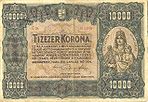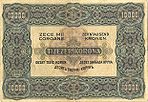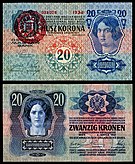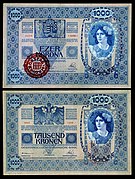Paper money of the Hungarian korona
The paper money of the Hungarian korona was part of the circulating currency in the post-World War I Kingdom of Hungary until the introduction of the pengő in 1927. The variety of the banknotes and treasury notes and the variety of issuing authorities reflect the chaotic postwar situation in the country.
Austro-Hungarian Bank notes (1919)
[edit]The Austro-Hungarian Bank, the central bank of Austria-Hungary, had the exclusive patent to print banknotes throughout the Austro-Hungarian Empire. Banknotes were printed in Vienna, Hungary was supplied from there. During the First World War, the chief secretary of the Vienna headquarters intentionally suspended the delivery of banknotes to Hungary.
After the World War, the Hungarian Károlyi government requested the Austro-Hungarian Bank to deliver printing plates and banknote paper to Hungary, since it would have been too dangerous to deliver printed banknotes due to the political uncertainty. The banknotes (1, 2, 25 and 200 crowns) printed in Budapest under the Károlyi government and then under the Hungarian Soviet Republic were distinguished with a different serial number (1 K: higher than 7000; 2 K: higher than 7000; 25 K: higher than 3000; 200 K: higher than 2000). After the fall of the Soviet Republic, Vienna declared these banknotes to be counterfeits.
| Austro-Hungarian Bank notes | |||||||
|---|---|---|---|---|---|---|---|
| Image | Value | Dimensions | Description | Date of | |||
| Obverse | Reverse | Obverse | Reverse | issue | withdrawal | ||
| 1 crown | 112 × 67 mm | Classic architecture pattern | Phrygian head | 30 April 1919 | 14 March 1922 | ||
 |  | 2 crowns | 123 × 83 mm | Female models | Female models | 25 May 1919 | 31 December 1922 |
 |  | 25 crowns | 135 × 80 mm | Female model | Plain or wavy pattern | 25 April 1919 | 11 November 1920 |
 |  | 200 crowns | 167 × 99 mm | Female model | Plain or wavy pattern | 20 May 1919 | 11 November 1920 |
| These images are to scale at 0.7 pixel per millimetre. For table standards, see the banknote specification table. | |||||||
Postal Savings Bank notes (1919)
[edit]The Postal Savings Bank notes (Postatakarékpénztári jegy) were issued under the decree of the Revolutionary Governing Council of the Hungarian Soviet Republic by the Magyar Postatakarékpénztár (Hungarian Postal Savings Bank), which was acting as the emission bank of Hungary then. The prewar high denomination banknotes of the Austro-Hungarian Bank were deposited at par to prevent inflation.
| Postal Savings Bank notes | |||||||
|---|---|---|---|---|---|---|---|
| Image | Value | Dimensions | Description | Date of | |||
| Obverse | Reverse | Obverse | Reverse | issue | withdrawal | ||
 |  | 5 korona | 132 × 80 mm | Male model | "Bill of the Hungarian Postal Savings Bank" | 6 June 1919 | 28 January 1923 |
 |  | 10 korona | 140 × 88 mm | Phrygian head | Value | 23 July 1919 | 28 January 1923 |
 |  | 20 korona | 145 × 90 mm | Phrygian head | Value in different languages | 23 July 1919 | 28 January 1923 |
 |  | 100 korona | 168 × 120 mm | Male model | Value in different languages | never | - |
 |  | 1,000 korona | 200 × 134 mm | Allegoric composition | Value in different languages | never | - |
| These images are to scale at 0.7 pixel per millimetre. For table standards, see the banknote specification table. | |||||||
Overstamped Austro-Hungarian Bank notes (1920)
[edit]Hungary was the last country among the successor states of the Monarchy to execute overstamping of the common money. The Károlyi government planned to start it on 21 March 1919, but the establishment of the Soviet Republic postponed these plans. Finally, the banknotes (the denominations from 10 to 10,000 crowns) were overstamped from 18 March 1920. Hungary used a red, round stamp to mark the banknotes.
| Overstamped Austro-Hungarian Bank notes | |||||||
|---|---|---|---|---|---|---|---|
| Image | Value | Dimensions | Description | Date of | |||
| Obverse | Reverse | Obverse | Reverse | issue | withdrawal | ||
| 10 crown | 150 × 79 mm | boy model | boy model | 24 July 1916 | 31 January 1924 | ||
| 20 crowns 2nd issue | 150 × 89 mm | female model | female model | 28 October 1918 | 31 January 1924 | ||
| 25 crowns | 135 × 80 mm | female model | plain or wavy pattern | 25 April 1919 | 11 November 1920 | ||
| 50 crowns | 162 × 100 mm | female model | female model | 18 December 1916 | 31 January 1924 | ||
| 100 crowns | 163 × 107 mm | female model | female model | 13 December 1912 | 30 September 1922 | ||
| 200 crowns | female model | ||||||
| 1,000 crowns | 191 × 127 mm | female model | female model | 2 January 1903 | 31 August 1921 | ||
| 10,000 crowns | 191 × 127 mm | female model | female model | 19 December 1918 | 5 June 1921 | ||
State notes (1920-1926)
[edit]State notes were first issued in 1921. The designer was Ferenc Helbing. The banknotes were first printed in Switzerland by Orell Füssli, Zürich (except for the lower denominations, which were not worth counterfeiting) then in Hungary by the newly founded Banknote Printing Co. (Magyar Pénzjegynyomda Rt.) in Budapest. The banknote size was increasing with the higher denominations, which prompted the press to resize the banknotes: from 1923, smaller versions were printed with the same (or slightly different) design.
Main state note printing mark variations:
- Low denomination bills (1 to 20 K, printed in 1920): no mark (printed in Budapest by different printers)
- Large size bills (50 to 25,000 K, printed in 1920 and 1922): ORELL FÜSSLI ZÜRICH
- Small size bills (100 to 1,000,000 K, printed in 1923 and 1923): ORELL FÜSSLI ZÜRICH or Magyar Pénzjegynyomda Rt. Budapest. or no mark (printed by the Magyar Pénzjegynyomda Rt. in Budapest)
- All large and small size notes (50 to 1,000,000 K): T. W. or W or T. WILLI to show the name of the inventor of the photo guilloche technique used to print the state notes (Traugott Willi ??? he prepared line drawing for a Swiss franc banknote [1])
| Low denomination series | |||||||
|---|---|---|---|---|---|---|---|
| Image | Value | Dimensions | Description | Date of | |||
| Obverse | Reverse | Obverse | Reverse | issue | withdrawal | ||
| 1 korona | 129 × 65 mm | Female model | Value in Hungarian and 5 foreign languages | 11 July 1921 | 30 June 1927 | ||
 |  | 2 korona | 131 × 76 mm | Peasant reaping wheat | |||
 |  | 10 korona | 135 × 79 mm | The Széchenyi Chain Bridge | |||
 |  | 20 korona | 143 × 84 mm | The Matthias Church, the Fisherman's Bastion, and the statue of János Hunyadi in the Buda Castle | |||
| Large size series | |||||||
| Image | Value | Dimensions | Description | Date of | |||
| Obverse | Reverse | Obverse | Reverse | issue | withdrawal | ||
 |  | 50 korona | 150 × 95 mm | Portrait of Ferenc II Rákóczi by Ádám Mányoki | Value in Hungarian and 5 foreign languages | 11 July 1921 | 30 June 1927 |
 |  | 100 korona | 155 × 100 mm | King Matthias | 9 May 1921 | 31 July 1926 | |
 |  | 500 korona | 170 × 110 mm | Prince Árpád | |||
 |  | 1000 korona | 193 × 125 mm | King St. Stephen | |||
 |  | 5000 korona | 205 × 135 mm | Hunnia | |||
 |  | 10000 korona | 211 × 144 mm | "PATRONA HUNGARIAE" | |||
 |  | 25000 korona | 213 × 147 mm | "PATRONA HUNGARIAE" | 6 September 1922 | ||
| Small size series | |||||||
| Image | Value | Dimensions | Description | Date of | |||
| Obverse | Reverse | Obverse | Reverse | issue | withdrawal | ||
| 100 korona | 119 × 72 mm | King Matthias | Value in Hungarian and 5 foreign languages | 18 March 1924 | 30 June 1927 | ||
 |  | 500 korona | 128 × 74 mm | Prince Árpád | 20 June 1924 | ||
 |  | 1000 korona | 136 × 78 mm | King St. Stephen | 15 September 1923 | ||
 |  | 5000 korona | 139 × 83 mm | Hunnia | 18 March 1924 | ||
 |  | 10000 korona | 145 × 88 mm | "PATRONA HUNGARIAE" | 18 March 1924 | ||
 |  | 25000 korona | 145 × 98 mm | King St. Ladislaus | 19 May 1924 | ||
 |  | 50,000 korona | 165 × 105 mm | Female model | 16 July 1923 | ||
 |  | 100,000 korona | 165 × 105 mm | Female model | 30 July 1923 | ||
 |  | 500,000 korona | 185 × 85 mm | Female model | 23 February 1924 | 30 June 1928 | |
 |  | 1,000,000 korona | 185 × 85 mm | Female model | 31 March 1924 | ||
| These images are to scale at 0.7 pixel per millimetre. For table standards, see the banknote specification table. | |||||||
After 25 August 1926 the 1,000 to 1,000,000 korona banknotes were overstamped to show the value in pengő (at the rate of 12500 korona to 1 pengő).
| State notes overstamped to pengő value | |||
|---|---|---|---|
| 1000 korona 8 fillér (0.08 pengő) | 5000 korona 40 fillér (0.40 pengő) | 10000 korona 80 fillér (0.80 pengő) | 25000 korona 2 pengő |
 |  |  |  |
| 50000 korona 4 pengő | 100000 korona 8 pengő | 500000 korona 40 pengő | 1000000 korona 80 pengő |
 | |||
External links
[edit]- (in Hungarian and English) bankjegy.szabadsagharcos.org (Hungarian banknote catalog)
- (in Hungarian and English) www.numismatics.hu (Roman and Hungarian related numismatic site)
- (in Hungarian) papirpenz.hu (pictures of Hungarian banknotes)
- (in Hungarian, English, German, and French) www.eremgyujtok.hu (homepage of the Hungarian Coin Collectors' Society)
- Pictures of Hungarian banknotes at Ron Wise’s World Paper Money Homepage, Archived June 3, 2011, at the Wayback Machine
Further reading
[edit]- (in Hungarian, English, and German) Gyula Rádóczy, Géza Tasnádi (1992). Magyar papírpénzek 1848-1992 (Hungarian paper money 1848-1992). Danubius Kódex Kiadói Kft. ISBN 963-7434-11-9.
- (in Hungarian) (summary in (in German, English, and Russian)) Károly Leányfalusi, Ádám Nagy (2006). A korona-fillér pénzrendszer - Magyarország fém- és papírpénzei 1892-1925 (The korona-fillér monetary system - coins and paper money of Hungary 1892-1925). Magyar Éremgyűjtők Egyesülete, Budapest. ISBN 963-229-523-4.


 French
French Deutsch
Deutsch









